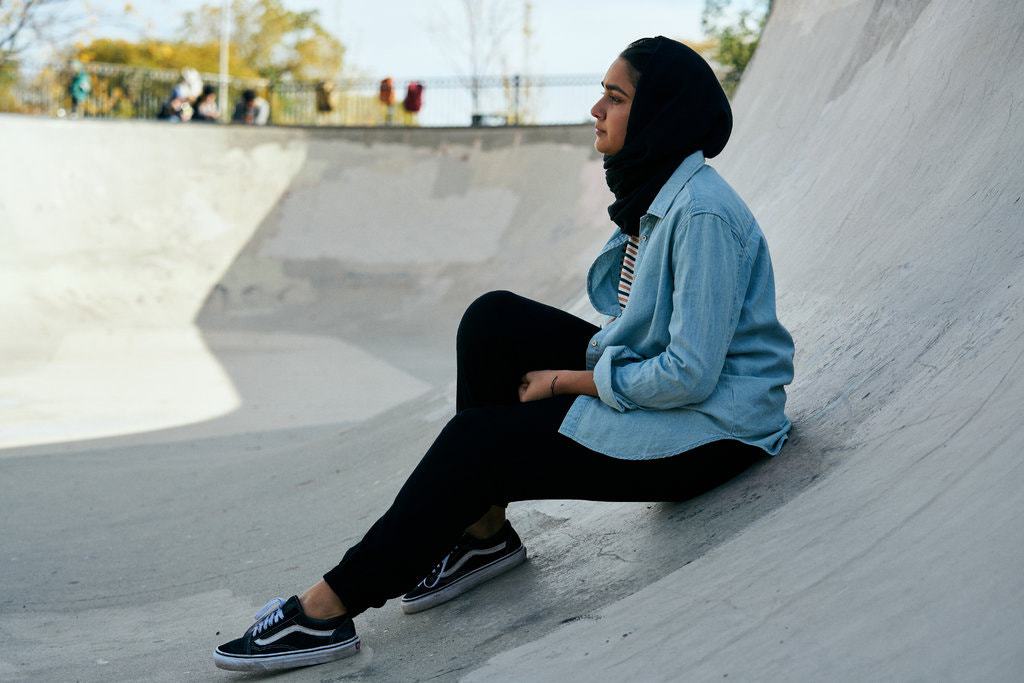Rihab Attioui, MA Postcolonial Studies
No, our critique only comes in one shade now: scathing.
The official trailer for Hala was released on 5 November 2019. Hala is a new film that supposedly made so many “waves” at Sundance that Apple deemed it worthy enough to purchase its worldwide distribution rights, streaming it exclusively on their brand-spanking-new heartless cash grab – sorry, streaming service, Apple TV+.
To briefly synopsise, Hala, is a coming-of-age story about a skateboarding, poetry-writing Muslim girl in the United States (isn’t it amazing that she skateboards and loves poetry and is Muslim?) constantly grappling with the expectations of her ‘traditional’ Pakistani-American parents and that white boy she wants to kiss so badly. Yes, this very evidently is a sarcastic and curt description of the film, but quite frankly, Muslim women have become so utterly fatigued with the inauthentic portrayal of supposed hijabis in the Western cultural landscape that films, like Hala, are no longer afforded polite and reserved constructive critique. No, our critique only comes in one shade now: scathing. If the eponymous Hala was the first of her kind, the golden unicorn of Muslim representation that Muslim women search so exhaustively for, perhaps our response would be different. But alas, Hala is just another part of a long and surreptitious Hollywood history of grossly and dangerously misrepresented Muslim women. What makes matters worse is that if there were ever a time for the dissemination and normalisation of Muslim-centred productions and narratives, it would be now. There exists a collective outcry for authenticity and a desacralisation of white stories in the zeitgeist. This outcry is palpably charged and revolutionary, demanding not simply the reform, but the decolonisation of cultural production and the public cultural space. It is this Millennial and Gen Z-led movement that has facilitated radical changes in Hollywood, such as creating the conditions for box office record-breaking Black-centred films, like Jordan Peele’s salient, Get Out. Not to mention, it has also made ubiquitous the condemnation of previously conventionalised practices like cultural appropriation and whitewashing.
In simple terms, today’s the day for a hijab-wearing character to be played by a hijab-wearing actress who keeps her hijab on and does not remove it for the plain-looking white boy in her school, who does not respect her religion nor her hijab.
Unfortunately yet unsurprisingly, this is not the case. What we have instead are insincere, superficial and painfully islamophobic caricatures; or more dangerously, Muslim characters battling their Islam and their cultures in favour of a romanticised ‘Western ideal’. This is found not just in Hala, but, in the Muslim portrayals of shows like Elite, Quantico, Homeland, and pretty much any American drama about an intelligence agency. What this effectively produces, is an insidiously Huntingtonian proposition in which Islam is positioned as the antithesis of Western liberation and freedom. The entire premise of Hala rests on the fact that she is caught in between her parents’ antiquated ideas of arranged marriage and how a culturally appropriate Muslim girl should behave, and the freedom she desires to be the cool skater girl who wants to engage in American dating practices. Essentially, she is presented as a girl whose Islam and Americanness are opposed. This does nothing but perpetuates the Bush-era narrative that Muslims cannot co-exist with Americans, nor any Westerners for that matter, as they are always in conflict. To demonstrate how Hala specifically has achieved this, take for instance this article titled, ‘One Way to Be a Muslim Girl in America’ in The Atlantic. The opening paragraph of the article states that this is a story of ‘Pakistan versus America; Islamic tenets versus romantic freedom’, explicitly suggesting the two are incompatible. Moreover, the review proceeds to describe Hala’s coming of age story as a ‘clash’ and a ‘binary’ multiple times, making direct references to the – widely discredited -notion of a civilizational clash, and invoking ideas of Muslim Westerners living in reductive binaries, instead of being cohesive and multidimensional people.
There is, of course, infinitely more critical cultural analysis this subject yields that can be more comprehensively engaged with in an academic capacity. However, we cannot reserve this conversation for just the academic space. Discourse on the dangers of Islamophobic representation in the Western cultural landscape must necessarily exist in mainstream and accessible spaces of popular culture and easily digestible journalism. Every Tom, Dick and Harry must be able to recognise the inequity of how Muslims are depicted as much as their Fatima, Khadija and ‘Hala’ counterparts. Perhaps then, this new generation of cultural revolutionaries can mobilise their structural power and effect substantive change in the way Muslim stories are told. Perhaps then, they can ground Muslim narratives in authenticity instead of dangerous subversion. Perhaps then, we may finally get a hijab-wearing character played by an actual hijab-wearing actress.
